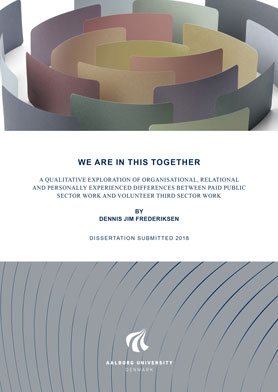We are in this Together. A Qualitative Exploration of Organisational, Relational and Personally Experienced Differences Between Paid Public Sector Work and Volunteer Third Sector Work
PhD Thesis by Dennis Jim Frederiksen
This is done on the backdrop of a current debate about increased involvement of volunteers in the public sector in Denmark. Part of this debate centres on what the increased involvement of volunteers in public sector work will do to the individuals’ experience of doing volunteer work. Some have argued that volunteering in the public sector would be unappealing to volunteers as public-sector work takes place under certain sectorial and organisational conditions, which are irreconcilable with the way volunteers prefer to work, and are used to working, in the third sector.
The thesis seeks a broader understanding of differences and similarities between the two types of work by conducting two case studies, where the same person is followed while doing volunteer third-sector work and paid public-sector work concurrently. The aim is to understand how the same person acts in, and responds to - the different types of work, rather than studying two separate groups of people, each doing one of the types of work.
A case study approach has been used, triangulating participant observation, video observation, interviews and documents. In terms of philosophy of science, the thesis is based on a combination of critical realism and philosophical hermeneutics.
Analysis has focused on three levels:
- the sectorial and organisational level detailing the structural conditions of the work,
- the situational level detailing the types of tasks and activities the work consisted of, and
- the relational and communicational level detailing how people in the two types of work interacted with, and related to, each other. Across these three levels, the thesis seeks to involve the experiences of the people doing the work as a way to understand not only how the work can be observed and described, but also how it is experienced.
In terms of findings, the thesis seeks to make three contributions
First, in the analyses chapters, the thesis seeks to contribute with qualitative insight into the numerous and complex ways the two types of work differ from each other in the selected cases. For example describing how the two types of work are structured differently, why that seems to be the case, and how this is experienced by the person working.
Secondly, in the discussion chapter, the analyses chapters are summarised by asking what these cases could be examples or cases of - when distanced somewhat from the details of the specific analyses. This is answered by formulating a number of potential differences between the two types of work, which are placed at each end of a continuum, one relative to the other. One example being that public-sector work takes place in organisations with a long distance between top and bottom (management and workers) - while on the other side of the continuum - third sector work takes place in associations with a shorter distance between top and bottom and less differentiation, if any, between positions of managers and workers. In addition to summarising differences found in the analysis, these potential differences also make up a contribution towards a theory of potentially distinctive features of paid and volunteer work in the two sectors respectively.
Thirdly, a specific finding in the analyses was, that the activities done in the third-sector associations seemed focused on the inherent values of doing these activities, rather than their instrumental value as tools for reaching outcomes separable from these activities. Doing activities for the inherent value of doing these activities took place in a third-sector association, which seemed structured around being a fellowship of people, existing for the sake of this fellowship of people. In other words, the activities seemed to match the fellowship of the organisation and they focused on the inherent values of doing activities - together in a fellowship. Focusing on these inherent values was made possible by a formalised organisational structure, where positions of authority didn’t demand separable outcomes of the activities nor had the authority to actually make this demand if they wanted to. This finding was sought summarised using the metaphorical statement: “We are in this together” as a way to describe the third-sector associations studied.
In contrast, the activities done in the paid public-sector work seemed focused on their instrumental value in reaching goals legitimately defined by politicians with the purpose of serving the population. Here, individuals solved tasks for their instrumental value in reaching separable outcomes, and this took place in organisational structures where legitimate top-down authority both required separable outcomes and also exerted top-down control to make sure the desired outcomes were reached. This finding was sought summarised using the metaphorical statement: “I am here to help you” as a way to describe the public-sector organisations studied.

